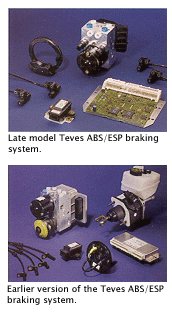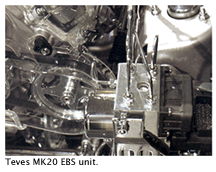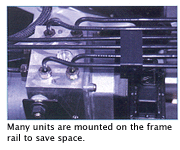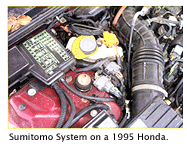Import anti-lock brake systems (ABS) are pretty much the same as domestic ABS systems. In fact, the same OEM suppliers who make the ABS system components for import vehicle manufacturers also make them for domestic vehicle manufacturers. The differences that do exist are typically limited to calibration, diagnostic codes and procedures, and wiring.
The ABS systems we’re talking about are ones made by Bosch, Kelsey-Hayes and Teves that have been used on both domestic and import vehicles. Various generations of Bosch ABS (Bosch 2, 5.0, 5.3, 5.7 and 8) can be found on numerous Japanese, European and domestic makes. Kelsey-Hayes is probably best known for their RWAL (rear wheel anti-lock system) and on Ford, GMC and Dodge trucks, but their 4WAL (four-wheel anti-lock) and EBC (electronic brake control) systems are used on various import, as well as domestic, trucks and SUVs. Teves (actually Continental Teves) likewise has its ABS systems on BMW, Chrysler, Ford, GM, Honda, Saab (now owned by GM) and Volkswagen models.
Bendix is another company who was in the ABS business for many years, and supplied systems to Chrysler and Jeep, but also Ford for their Contour model from 1995-98. But the Bendix ABS division was bought out by Bosch a number of years ago and is no more.
Delphi (formerly AC Delco) is another major supplier of ABS systems. But Delphi Powermaster III, ABS-VI and DBC-7 systems are only found on GM makes.
Other major OEM ABS suppliers include Nippondenso (for Infiniti and Lexus), Sumitomo (Mazda, Honda and older Ford Probe and Escort models), and Toyota (made their own rear wheel ABS system for older pickups).
Unfortunately, you can’t always tell what kind of ABS system is on a vehicle just by looking at it or by reading the service literature. Sometimes the vehicle manufacturer will say who supplies their ABS system in their service literature, but usually they don’t. Consequently, you may not realize that there are many similarities in diagnosis and repair procedures on different vehicles that have essentially the same or very similar ABS systems.
 In spite of their differences in external appearance (and lack of interchangeability of parts), most ABS systems can be lumped into one of several basic categories:
In spite of their differences in external appearance (and lack of interchangeability of parts), most ABS systems can be lumped into one of several basic categories:
“Rear-wheel only” ABS systems on older trucks and vans. A single solenoid valve is used to prevent rear-wheel lockup. Most also use a single wheel-speed sensor for both rear wheels.
Older “integral” ABS systems that combine the master cylinder and ABS hydraulic modular into a large and very expensive assembly. The ABS pump and accumulator provide power-assisted braking and no vacuum booster is used.
The only integral ABS system used on import applications is the Teves Mark 2, found on 1987 & up Saab 9000, 1988 to 1989 Merkur Scorpio, 1988 to 1991 Peugeot 505, 1991 & up Saab 900, and 1991 & up Volkswagen Passat. The Teves Mark 2 accumulators contain more than 2,700 psi, so they must be depressurized prior to working on the brakes by pumping the brake pedal 25 to 40 times while the key is off.
Non-integral ABS systems that use a conventional master cylinder and a separate ABS hydraulic modular. A vacuum booster is used for power assist and the ABS system only comes into play when wheel slip is detected while braking. Some of the older systems were “three channel” control systems that used a single wheel-speed sensor for both rear wheels. Most newer systems are “four channel” systems with a separate wheel-speed sensor for each wheel.
Some non-integral ABS systems also have an electric pump for ABS braking (to reapply pressure during the ABS hold-release-reapply cycle), but do not use the pump for power assist. That means non-integral systems do not have to be depressurized or deactivated prior to working on the brakes. On some applications, though, the pump and accumulator can apply the brakes for traction control (if so equipped).
 Non-integral systems include Bosch 2, 2E, 2U, 5.0 & 5.3 ABS, Kelsey-Hayes 4WAL & EBC325 ABS, Honda ABS, Nippondenso ABS, Sumitomo ABS and Teves Mark 4 & 20 ABS.
Non-integral systems include Bosch 2, 2E, 2U, 5.0 & 5.3 ABS, Kelsey-Hayes 4WAL & EBC325 ABS, Honda ABS, Nippondenso ABS, Sumitomo ABS and Teves Mark 4 & 20 ABS.
Electrohydraulic “brake assist” and “brake-by-wire” systems that combine power- assisted braking, ABS, traction control and stability control. These are very compact, very sophisticated systems that use a variety of sensors’ inputs (individual wheel speed, vehicle speed, yaw rate, lateral acceleration and steering angle) to control braking and handling.
Getting Started
In spite of their complexity, most ABS systems are pretty reliable and cause few problems. So unless the the ABS warning lamp is on, or there is a braking complaint that may be ABS-related (such as the ABS kicking in during normal braking, or not kicking in when it should, or unusual noises or vibrations when braking, or loss of pedal, etc.), there’s really no reason to diagnose something that isn’t causing a problem. If the vehicle needs new brake linings and everything seems to be functioning normally (no complaints), you can essentially ignore the ABS system altogether.
ABS problems typically start to occur after years of service or at high mileage. Over time, rust and corrosion inside the brake system can plug up filter screens inside the ABS modulator, and sometimes even the ABS valves causing various ABS and braking problems.
Electrical connections between the wheel-speed sensors, ABS module, pump motor and power relay may become corroded or loose. Most wheel-speed sensors are magnetic and can become contaminated with metallic particles from brake linings or rotors (or wheel bearings in the case of integral wheel-speed sensors that are part of a sealed hub and bearing assembly). Accumulators can develop leaks, pumps can wear out and relays can fail. Moisture can cause corrosion in the module and electrical connections (watch out for vehicles that have been flood damaged).
As a rule, serious ABS faults (like a wheel speed failure, accumulator leak, pump motor failure, shorted or open ABS solenoid valve, etc.) will usually be detected by the ABS self-diagnostics. Serious faults that affect the ability of the system to operate normally will set a diagnostic trouble code and turn on the ABS warning lamp. At the same time, the ABS system will usually disable itself. On most vehicles, this should not affect normal braking. But on vehicles that also use the ABS system for power-assisted braking, it will cause an increase in pedal effort when braking. If it’s a newer vehicle with traction control and/or stability control, those functions may also be disabled.
 With few exceptions, reading ABS codes requires a scan tool (usually a factory scan tool or an equivalent aftermarket professional grade scan tool with ABS-capable software). Some of the older systems provide manual flash codes (Toyota rear-wheel ABS and Kelsey-Hayes RWAL, for example), and on some vehicles ABS codes can be accessed through the driver information center using a special diagnostic procedure.
With few exceptions, reading ABS codes requires a scan tool (usually a factory scan tool or an equivalent aftermarket professional grade scan tool with ABS-capable software). Some of the older systems provide manual flash codes (Toyota rear-wheel ABS and Kelsey-Hayes RWAL, for example), and on some vehicles ABS codes can be accessed through the driver information center using a special diagnostic procedure.
In any event, once you read an ABS code by whatever means, the next step is to refer to the vehicle manufacturer’s diagnostic charts and wiring diagrams. Auto repair today often requires as much preliminary research as it does diagnosis before you can accurately identify and fix a fault. So if you are not using an electronic database, the internet or the vehicle manufacturer’s technical websites, you may not be able to fix some of the ABS problems you’re likely to encounter on late-model vehicles.
Warning: If the brake warning lamp is on, the vehicle may have a hydraulic problem with the brakes, not the ABS system. There may be a fluid leak or loss of pressure in a brake circuit. Either condition may create a serious safety hazard. The vehicle should not be driven until the cause is diagnosed and repaired.
Wheel-Speed Sensor Checks
You can check virtually any magnetic wheel-speed sensor by measuring its resistance with an ohmmeter, but you need to look up the exact specifications for the vehicle because they can vary significantly from one application to another. For instance, older Toyota Camrys and Porsches both use a similar Bosch 2 ABS system. Yet the specs for the rear wheel sensors on the Toyota are 900 to 1,200 ohms versus 1,600 to 1,800 ohms for the Porsche. Why? Who knows. But, if the wheel-speed sensor is out of specifications, it won’t produce an accurate signal that the ABS control module can read.
Magnetic wheel-speed sensors generate an alternating current (AC) signal that increases in frequency and amplitude as wheel speed increases. Because the sensors are magnetic, they can attract metallic debris from semi-metallic brake linings and rotors that stick to the tip and interfere with the signal. If the ABS module doesn’t see a clean WSS signal, it may think there’s something wrong and set a wheel-speed sensor code. Even a tiny nick in the tone ring around the outer CV joint or on the rotor may be enough to disrupt the signal.
The distance or “air gap” between the end of a wheel-speed sensor and its ring is critical. A close gap is necessary to produce a strong, reliable signal. You don’t want metal-to-metal contact between the sensor and its ring since this would damage both. But neither do you want too much clearance. An air gap that’s too wide may produce a weak or erratic signal, or, worse yet, no signal at all. So if a wheel speed sensor is adjustable (many are not), refer to the service literature for the required air gap and adjust it to specs. Insert a nonmagnetic brass or plastic feeler gauge between the end of the sensor and ring, and then tighten the set screw that locks the sensor in place.
 Some sensors come with a piece of paper or plastic over the end that provides just the right gap when the sensor is installed. To install this type of sensor, it is inserted until it just touches the sensor ring, then backed off just enough so the ring will turn without rubbing against the spacer. Tightening the set screw locks it in place.
Some sensors come with a piece of paper or plastic over the end that provides just the right gap when the sensor is installed. To install this type of sensor, it is inserted until it just touches the sensor ring, then backed off just enough so the ring will turn without rubbing against the spacer. Tightening the set screw locks it in place.
A good wheel-speed sensor will generally produce an alternating current (AC) voltage reading of 50 to 700 MV when the wheel is spun at a speed of about one revolution per second. Use a digital multimeter or a digital storage oscilloscope to check the sensor’s output.
If the voltage reading is low or nonexistent, check the sensor’s resistance (with the key off). You can do this at the wheel or by using a breakout box in the ABS module wiring harness. Measuring at the harness will also check the continuity of the circuit. If you get a low reading at the harness, check the wheel-speed sensor. If the sensor is within specs (typically 800 to 1,800 ohms), the problem is in the wiring, not the sensor.
If you’re using a scope to check a wheel speed sensor circuit, a signal pattern that is flattened (diminished amplitude) or is erratic usually indicates a weak signal caused by an excessively wide air gap between the tip of the sensor and its ring, or a buildup of metallic debris on the end of the sensor. A weak signal can also be caused by internal resistance in the sensor or its wiring circuit, or loose or corroded wiring connectors.
Pumps and Accumulators
Pumps generate pressure and accumulators store pressure. A bad relay can prevent the pump from running as can a blown fuse, loss of power or ground in the pump circuit. If the pump runs when the fuse is replaced, it may tell you the pump has been overworking because of a leaky accumulator that isn’t holding pressure. Accumulators typically leak at the point where they screw into the pump or modulator assembly.
Warning: Do not attempt to remove an accumulator until the system has been depressurized.
No Code Diagnosis
The hardest ABS problems to troubleshoot are those that don’t set a fault code or turn on the ABS warning lamp. These may be intermittent faults and may be caused by environmental factors (heat, cold or moisture), or by something other than the ABS system itself (such as dirty brake fluid that contains debris, a sticking, dragging or leaking brake caliper, warped rotor, variations in rotor thickness, wrong brake linings or contaminated brake linings, changes in wheel and/or tire sizes, electrical glitches in the wiring or charging system, etc.).
First, make sure the ABS warning lamp is not burned out. The bulb should come on for a few seconds when the ignition is first turned on. No light means the bulb has failed or there is a problem in the warning lamp circuit.
Another overlooked cause of ABS faults (and other driveability problems) can be a low battery and/or low charging output. Electronic modules need a reliable 12 volts to operate normally, so if voltage isn’t up to specs for whatever reason, it may cause the system to misbehave or act strangely.
If there are no ABS codes and you suspect an ABS problem, the first thing to do is to rule out basic brake problems by thoroughly inspecting the brakes. In other words, don’t blame the ABS system for something that isn’t an ABS fault. Check the master cylinder, brake lines and hoses, proportioning valves, calipers, wheel cylinders, brake pads and shoes, rotors and drums. If the brake system appears to be in good working condition, but the ABS system is operating erratically or abnormally (kicking in during normal braking or not preventing wheel lockup when braking hard on wet or slick surfaces), the most likely cause is probably a wheel-speed sensor fault or a system calibration issue.
Some ABS systems are more sensitive than others to subtle changes in wheel speed. Every ABS system in existence is calibrated for a specific vehicle application (a specific size and class of vehicle, a specific weight range, a certain tire and wheel size, and the individual braking characteristics of that vehicle). Any modifications that may have been made to a vehicle that significantly change any of these perimeters may upset the normal operation of the ABS system.
If someone has replaced the original rear brake linings with ones that are more aggressive than the original linings, it may be enough to trip the ABS system when it really isn’t needed. Other changes that may upset the operation of the ABS system include raising or lowering vehicle height, installing oversize or undersized wheels/tires (plus sizing is usually OK as long as the outside diameter of the tire/wheel assembly remains the same as the original), and modifying the suspension (making it lower or stiffer).
In some cases, the original calibration of the ABS system may be overly-sensitive. The vehicle manufacturer may have issued a technical service bulletin (TSB) that recommends reflashing the ABS module with revised operating instructions (you’ll need a factory scan tool or equivalent with the appropriate pass-thru flash capability to do this). But the only way you’ll know whether or not a reflash is needed is to search a database of manufacturer TSBs via Alldata (www.alldata.com), Mitchell (www.mitchellrepair.com), or the OEM vehicle manufacturer technical websites (a complete list is available at www.iatn.net/nastf/oematrix.pdf).













